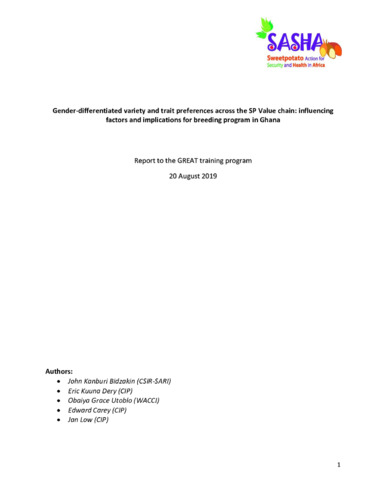Gender-differentiated variety and trait preferences across the SP Value chain: influencing factors and implications for breeding program in Ghana
Abstract
Improved knowledge on gender-differentiated trait preferences could help identify options for breeding programs to better respond to gender-specific needs, and possible ways as to how they might need to change in order to better integrate gender considerations. The study use quantitative method. A multi-phase (purposive and random) sampling approach was used to identify 135 farmers, 60 traders and 60 consumers across northern and upper east regions of Ghana. Majority of producers in Northern region prefer to cultivate Apomudem variety whiles in the Upper east region majority of producers prefer to cultivate Obaari. Most traders in northern regions prefer to trade in Apomuden whiles those of upper east region prefer Obari. Obaari is also the most preferred variety by female traders whiles male traders prefer Apomuden. Consumers from Northern region prefer to consume Apomuden more and consumers from Upper east region prefer to eat Obaari. The study further revealed that Obaari is the most preferred SP variety by female consumers. The main factor that influenced Northern producers’ choice of Apomuden as their preferred variety was because of its health benefits however the choice of Obaari by upper east producers is influenced by its high yielding ability. Male producers’ choice of preferred SP variety is influenced by the health benefits followed by the high demand for it. Trader’s variety choice from Northern and Upper east regions respectively indicated high demand as their influencing factor. SP consumers in Northern and Upper East region indicated their choice of variety is influenced by its associated health benefits. Good taste of roots is the first most important trait followed by high yielding as the second most important trait by both female and male producers. The level of agreement among female producers’ ranks is not strong compared to their male counterparts. Female SP traders ranked good market price of their preferred SP variety as the most important trait that influenced their choice of variety. The level of agreement among them is not strong and that of the male traders is relatively stronger. Both female and male consumers interviewed ranked the nutritional value as the first most important trait of their preferred SP variety. Generally there are differences in the trait preferences of the value chain actors and also gender differences. The level of agreement among the different actors and gender groups is not very strong. Producers agreed that they determine SP price and male producers were satisfied with the selling price. Female and male producers in the study agreed their supply met the market demand. The study revealed female producers obtain SP market price information from family members or from friends and male producers obtained their SP market price information from farmer group associations. All traders were satisfied with the current varieties in the system. Consumers were satisfied with the market supply of preferred SP varieties in the market and consumers were also satisfied with the market’s supply of SP varieties whereas consumers were equally satisfied with the market supply. Female producers ranked pest and disease attack as the most important constraint in producing SP, followed by lack of access to credit. Female producers ranked lack of storage techniques as their third most important constraint whiles male producers rank high cost of inputs as the third most important constraint. Female traders ranked SP going bad easily as their first most important constraint whereas lack of access to proper marketing systems by male traders. The results show that there are gender-differentiated preferences hence gender analyses is important in providing information to guide the formulation of breeding objectives for effective and efficient breeding.

